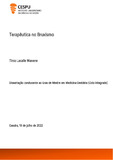| dc.contributor.advisor | CARDOSO, MÓNICA ALEXANDRA GUEDES | |
| dc.contributor.author | Manene, Tirso Lacalle | |
| dc.date.accessioned | 2022-11-04T10:44:58Z | |
| dc.date.available | 2022-11-04T10:44:58Z | |
| dc.date.issued | 2022 | |
| dc.identifier.uri | http://hdl.handle.net/20.500.11816/4043 | |
| dc.description.abstract | A vida moderna acarreta altos níveis de stress na população jovem e de meia-idade, o que possibilita o aumento da prevalência de bruxismo.
Para a elaboração desta revisão sistemática integrativa foi efectuada uma busca na base de dados PubMed usando as seguintes expressões de busca: ((Bruxism) AND (Etiology)); ((Bruxism) AND (Treatment)); ((Bruxism) AND (Therapy)). Foram incluindo artigos científicos em inglês, dois últimos 10 anos, obtidos na íntegra. Um total de 34 artigos científicos foi selecionado de acordo com esses critérios de inclusão e exclusão.
A etipatologia do bruxismo ainda não está bem definida. Sabemos que pode estar relacionado com o stress, fatores genéticos e ambientais, o sistema nervoso central e tabagismo.
As goteiras oclusais são o tratamento de primeira escolha mas só atuam para prevenir os efeitos adversos nas estruturas dentárias. Há necessidade de mais estudos sobre diferentes alternativas para combater o bruxismo, como a toxina botulínica, as terapias alternativas ou farmacológicas, e como usá-las em combinação. | pt_PT |
| dc.description.abstract | Modern life entails high levels of stress in the young and middle-aged population, which enables an increase in the prevalence of bruxism.
To prepare this integrative systematic review, a search was conducted in the PubMed database using the following search expressions: ((Bruxism) AND (Etiology)); ((Bruxism) AND (Treatment)); ((Bruxism) AND (Therapy)). Scientific articles were included in English, two of the last 10 years, obtained in full. A total of 34 scientific articles were selected according to these inclusion and exclusion criteria.
The etipathology of bruxism is still not well defined. We know that it can be related to stress, genetic and environmental factors, the central nervous system and smoking.
Occlusal drips are the treatment of first choice but they only act to prevent adverse effects on dental structures. There is a need for more studies on different alternatives to combat bruxism, such as botulinum toxin, alternative or pharmacological therapies, and how to use them in combination. | pt_PT |
| dc.language.iso | por | pt_PT |
| dc.rights | info:eu-repo/semantics/openAccess | pt_PT |
| dc.subject | Bruxism | pt_PT |
| dc.subject | Occlusal Splint | pt_PT |
| dc.subject | Botulinum Toxin | pt_PT |
| dc.subject | Therapy | pt_PT |
| dc.subject | Etiology | pt_PT |
| dc.title | Terapêutica no Bruxismo | pt_PT |
| dc.type | info:eu-repo/semantics/masterThesis | pt_PT |
| dc.identifier.tid | 203076176 | pt_PT |
| thesis.degree.name | Mestrado em Medicina Dentária | pt_PT |

